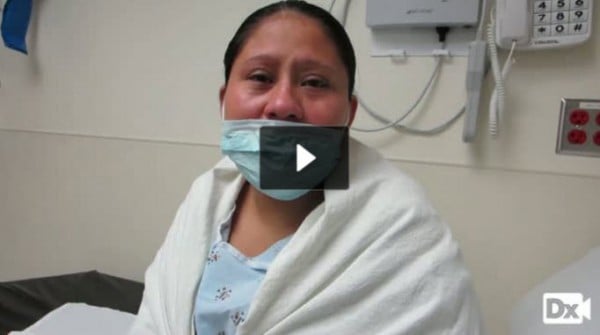26 y/o female with acute onset of cough and dyspnea during pregnancy
Patient will present as → a 45-year-old female presents to the clinic with a 5-day history of cough and feeling generally unwell. She reports the cough started as a dry, irritating cough but has since progressed to a productive cough with yellowish sputum. She denies any shortness of breath or wheezing but mentions mild chest discomfort with coughing. She also reports a low-grade fever and malaise. On examination, her temperature is 37.8°C (100.4°F), her respiratory rate is 18 breaths per minute, and her oxygen saturation is 98% on room air. Scattered rhonchi are heard throughout all lung fields. A diagnosis of acute bronchitis is made. The patient is advised about the viral nature of most acute bronchitis cases, meaning antibiotics are not indicated. She is counseled on symptomatic management, including increased fluid intake, rest, and over-the-counter cough suppressants and analgesics as needed for comfort. She is advised to return if symptoms worsen or if she develops shortness of breath, high fever, or persistent symptoms beyond a few weeks. A follow-up phone call in a week is scheduled to assess her progress.
Acute bronchitis is an inflammation of the bronchial tubes (the airways that carry air to the lungs). It typically develops from a cold or other respiratory infection and is characterized by the production of mucus (sputum), coughing, and sometimes shortness of breath and wheezing
- Symptoms include cough that may be productive (yellow sputum), white nasal discharge, sore throat, and fatigue
- Auscultation of the lungs may reveal scattered rhonchi and wheezes
- A low-grade fever is common - but a high fever is unusual in acute bronchitis. If your patient has a fever, consider pneumonia
- (95%) of acute bronchitis are viral
- Bacteria, such as Mycoplasma pneumoniae, Bordetella pertussis, and Chlamydia pneumoniae, cause less than 5% of cases and sometimes occur in outbreaks
Chest X-ray if the diagnosis is uncertain or symptoms have persisted despite conservative treatment
Since most cases (95%) are viral, symptomatic treatment is the cornerstone of management:
- Supportive measures include hydration, expectorants, analgesics, β2-agonists, and cough suppressants as needed (not recommended for children)
- For patients who desire medication for cough offer over-the-counter medications such as dextromethorphan or guaifenesin rather than other medications
- Reserve use of inhaled beta-agonists, such as albuterol, for patients with wheezing and underlying pulmonary disease
- For acute exacerbations of chronic bronchitis, in which bacterial causes are more likely, empiric first-line treatment is a second-generation cephalosporin; second-line treatment is a second-generation macrolide or trimethoprim-sulfamethoxazole
- Antibiotics are indicated for the following: elderly patients, those with underlying cardiopulmonary diseases and cough for more than 7 to 10 days, and any patient who is immunocompromised
Question 1 |
Azithromycin 500mg day 1, then 250mg daily for 4 days Hint: Antibiotics which are usually not indicated in the treatment of acute bronchitis | |
Amoxicillin 875mg twice daily for 7 days Hint: Antibiotics are usually not indicated in the treatment of acute bronchitis | |
Increased fluids and ibuprofen | |
Give the patient an albuterol inhaler Hint: Albuterol, is a beta-agonist used as a bronchodilator (usually in asthma); here, it should be used only if there is evidence of bronchoconstriction. | |
Chest x-ray and sputum culture Hint: These are typically reserved for patients with suspected complications, signs of pneumonia, or those who aren't improving with supportive care. |
Question 2 |
Prescribe a macrolide antibiotic | |
Obtain a chest x-ray Hint: While a chest x-ray might be considered in certain cases (e.g. ruling out pneumonia), it's not necessary in this case as the patients PE is normal and O2 sat is 100% on RA. | |
Administer an oral corticosteroid Hint: Corticosteroids might have a role in reducing inflammation in some bronchitis cases, but they are not routinely used as initial treatment, especially when bacterial infection is possible. | |
Pulmonary function tests Hint: Pulmonary function tests in acute bronchitis are not necessary, except in very serious cases. | |
Order a sputum culture Hint: Sputum cultures can be helpful to pinpoint the specific bacteria involved, but it's not always necessary upfront when empiric antibiotic therapy is appropriate. |
Question 3 |
Streptococcus pneumoniae Hint: The same bugs that cause upper respiratory infections cause acute bacterial bronchitis: H. influenzae, M. Catarrhalis and S. Pneumonia | |
Respiratory viruses | |
Haemophilus influenzae Hint: The same bugs that cause upper respiratory infections cause acute bacterial bronchitis: H. influenzae, M. Catarrhalis and S. Pneumonia | |
Mycoplasma pneumoniae Hint: Causes "atypical" pneumonia and can occasionally include a bronchitis component, but usually isn't the single-leading reason for an acute uncomplicated bronchitis-like picture. | |
Moraxella catarrhalis Hint: The same bugs that cause upper respiratory infections cause acute bacterial bronchitis: H. influenzae, M. Catarrhalis and S. Pneumonia |
Question 4 |
Starting Oseltamivir 75 mg within the first two days of symptom onset Hint: Starting Oseltamivir 75 mg within the first two days of symptom onset is aimed at treating influenza rather than serving as a prophylaxis for acute bronchitis. While it can reduce the severity and duration of influenza, it is not a preventive measure for bronchitis itself. | |
Receiving the influenza vaccination | |
Using inhaled corticosteroids regularly Hint: Using inhaled corticosteroids is typically part of the treatment regimen for chronic respiratory conditions like asthma or COPD to reduce inflammation and prevent exacerbations, not as a prophylaxis for acute bronchitis. | |
Vitamin C daily Hint: Common misconception about cold prevention despite lack of strong evidence | |
Amoxicillin pulse dosing Hint: Not a recommended preventive measure |
|
List |
References: Merck Manual · UpToDate



